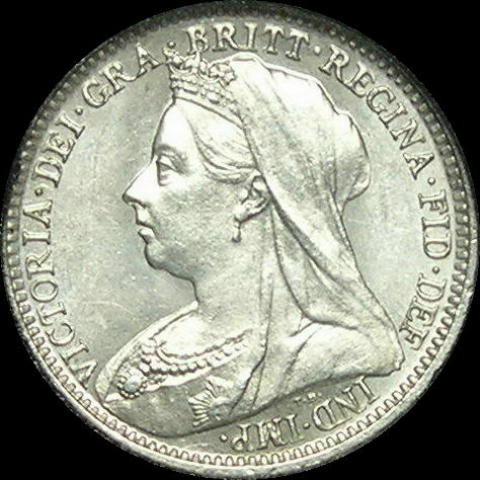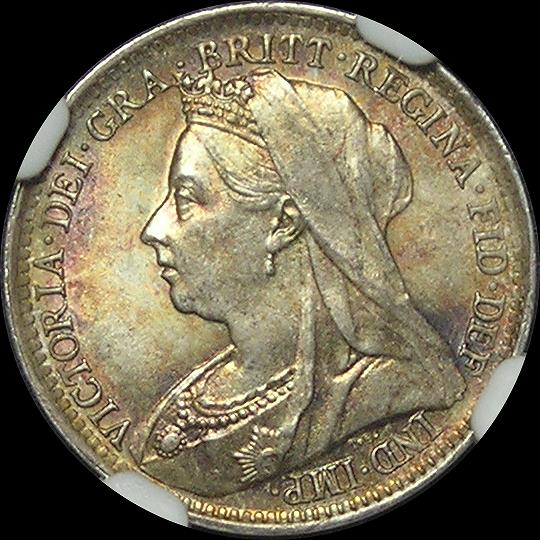Ever been tempted to clean your coins?
I have on a number of occasions, though I have never done anything but acetone rinses. Going through some of my pieces recently, I once again learned to my dismay just how devastating cleaning is, as if I hadn't already known.
Obverse of 1895 threepence, absolutely fabulous:

Obverse of 1894 threepence, in UNC condition at some point, wiped by some idiot. I didn't have a good magnifier on me so it fooled me at the time. Oh, the horror!

Obverse of 1895 threepence, absolutely fabulous:

Obverse of 1894 threepence, in UNC condition at some point, wiped by some idiot. I didn't have a good magnifier on me so it fooled me at the time. Oh, the horror!

Former owner, Cambridge Gate collection.
0
Comments
I remember cleaning a penny with jewelry cleaner when I was first starting to collect...
It was REALLY bright and shiny!
-------------------------
Good trades with: DaveN, Tydye, IStillLikeZARCoins, Fjord, Louie, BRdude
Good buys from: LordMarcovan, Aethelred, Ajaan, PrivateCoinCollector, LindeDad, Peaceman, Spoon, DrJules, jjrrww
Good sale to: Nicholasz219
I have had a few that came out well and several that were not such a good result. A tiny handful of terrific saves and a small handful of pieces I ruined. Most come out so-so.
Usually I clean only when there's gunk or unsightly toning. Mostly the removal of gunk with acetone or of plain old dirt with Vaseline is as far as I go. But I do dip unevenly toned or mottled silver sometimes.
Being a metal detectorist, one has to clean coins quite often when they come from the ground. I learned a few tricks there, but seldom will I use those methods on a nondug coin. My dug coin cleaning kit includes tools that would horrify the traditional numismatist, like brass wire brushes, steel wool, toilet bowl cleaner (acid), and so on. But that's for the hardluck cases.
I tried some electrolysis (not hair removal!!) and really had some excellent results but then managed to ruin an 1886 halfcrown. I had a lot of practice and thought I was "the man" and got shot back to earth.
On the other hand I had a 1936 GB penny that I could not tell for sure was proof (folks, DO NOT try this at home), cleaned the surface with electrolysis and wow did I ever have a proof!
Well, just Love coins, period.
Thanks,
Hus
I'm talking about a very brief dip in "MS70-coin brightener", followed by a dip in hot distilled water and a rinse in 100% acetone.
I've done this only once before on a South African proof coin of small value (visual experimental thread exists from about 2 years ago), and it seemed to work well.
Hey, I love toning; however, initially the reddish toning and hazing on the reverse struck me as ugly- not to mention the spots on the obverse, but what do you think? Dippage?
Ed for spl
is that you end up being governed by inferiors. – Plato
1 - electrolysis: you may laugh but I use(d) an old cell phone charger and cut the end off and had two wires, positive and negative. I put the black to ground and made a wire hoop out of stripped wire so that I would not have to put an alligator clip on the coin. The electrolyte solution was tap water plus a pinch of sodium chloride. I played with lots of pocket change to see how it would work and did a google search for electrolysis, and then adapted techniqui.
I must admit to not having gone back to it for two years after the halfcrown experience - I think that coin may have been dipped with residue on it and the reaction was a complex with the residue & therefore suggest trying to get even the practice coin surface as clean as possible before going forward with it. Kind of fun to have those tiny bubbles come up off the surface of the coin and see grunge to disappear when it is working. Please experiment with pocket change first, and work on some EF common date silver just to see how it goes first would be my advice.
I lost the digital camera (which I was not too great with anyway) by way of significant other girlfriend going one way and me another so maybe have to get up off a dime and get another.
2 - That red oxidation on the Goya is very similar to what a lot of Mexican Libertads seem to get, and it recurrs (sp?) but can be dipped in jewel luster, etc. If you dip, you should ALWAYS wash liberally with water (I use tap water for this stage), and then I wash with my fingers and a mild dish detergent, and then tap water, and then distilled water with tamp dry only afterwards to get the jewel luster or whatever off. NO rubbing with Q-tips if you can avoid.
Remember the more you dip, the more luster can be lost so watch carefully. I noticed, and nobody had ever written about it before that as you remove a coin from dip, oxidation of the surface is still going on so you have to count as dip time all the time it takes until it is rinsed off.
Whew, well hopefully that helped a little. Will try to get back Mon. or Tues. to an electrolysis discussion maybe.
Well, just Love coins, period.
Great results on that coin. How did you clean it?
<< <i>Wow Preussen,
Great results on that coin. How did you clean it? >>
Thanks, but I didn't "clean" it, I "conserved" it
THat was a nice clean up Job. It really made a difference and doesn't look stripped.
<< <i>Sorry. >>
<< <i>Did you send it to NCS for conservation? >>
No, I did it myself
<< <i>Preussen
THat was a nice clean up Job. It really made a difference and doesn't look stripped. >>
Thanks; I am pleased with the results